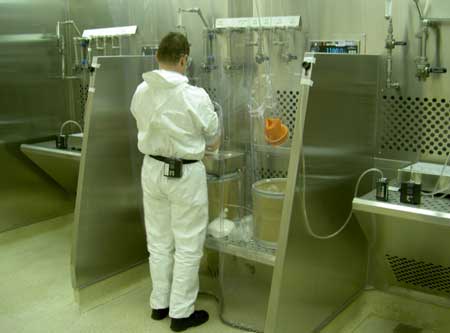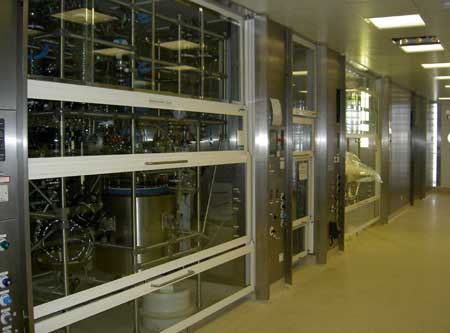What kind of sample?
Personal sampling
One of the first questions you need to answer is whether you need to take a personal or static (sometimes called 'area') sample.
Personal sampling involves a device worn by the worker, positioned so that it draws air from the "breathing zone" (i.e. within a few centimetres of their nose and mouth). Consequently, it will normally give a good indication of the worker's average exposure during the period it was worn.
This type of sampling is preferable when deciding whether a worker's exposure is above or below an occupational exposure limit.

Image source: Wikipedia
Static (area) sampling
As the name suggests, the sampling device is located at a fixed position.
Consequently, it does not give us information about the concentration workers are actually exposed to, as they normally will move around the workplace.
However, static samples can provide useful information, including helping to:
- Identify leaks
- Quantify peak concentrations
- Monitor the effectiveness of controls
- Measure background levels
- Determine the potential for spread of contamination.
Sometimes practical considerations mean that we have to take static rather than personal samples - for example, when sampling devices are too heavy or cumbersome for workers or it is inappropriate for other reasons (e.g. sterile environments).

Image courtesy of author
Worst-case or representative samples?
In most situations it is likely that there will be considerable variation in results obtained for different workers and different shifts, even when they are working on the same process.
If we want to reflect the full extent of the variation we would have to take a lot of samples covering all the possible variations over several different shifts. This is unlikely to be feasible as it would involve considerable time and expense, so we have to be selective about the number of samples we take and when we take them.
There are two main approaches we can adopt: worst-case and representative sampling.
Worst case sampling
It is often possible to establish when exposures are likely to be at their highest (for example, when the production rate is highest).
If we collect worst-case samples, then we can safely assume that we are obtaining the highest estimate of exposure. Then if the results are below our chosen exposure limit, then we have some confidence that the limit will not be exceeded on other occasions.
However, sometimes all or some of the results may be above the exposure limit. What would you do then?
Implementing controls would be the right thing to do in many situations, as we know that exposures can exceed the limit. However you have to be a little careful if the "worst case" situation only occurs on rare occasions and the controls are likely to be expensive to implement. Under these circumstances it might be advisable to take temporary measures (e.g. instruct workers to wear respirators) and carry out further sampling to obtain a better picture of exposure under "representative" conditions.
Representative sampling
In this case we try to obtain a number of samples which reflect the range of "typical" exposures associated with the process using different workers where possible. From the results we can determine the mean (average) exposure as well as the range. This may mean that we have to take more samples than if we adopt the "worst case" approach, but we will then obtain more data reflecting the extent of exposures that can occur under different circumstances.
Example scenarios

Image courtesy of author
A powder pharmaceutical active is blended in 3 rooms at your site. The batch process takes several hours and no one person remains in any of the rooms during the entire time powder is being handled/blended.
Example 1
You have just received an email that states the powder has been found to be associated with psychological disorders and, as a result, a new occupational exposure limit (OEL) of 0.03mg/m³ has been adopted by your company. The first step would be to review the risk assessment and implement any temporary controls required. The risk assessment review indicated the need for air sampling.
In this situation, what type of sampling would you undertake?
To determine exposure (and to compare with OELs), personal samples would be required, especially since workers move from room to room. In fact, in many cases, a combination of personal and static samples will be required as they complement each other and provide a better understanding of the potential exposure of all workers.
Which sampling strategy would you use?
Worst case sampling. Representative information about average exposure is of little interest here. The primary objective in this case would be to determine if any of your workers exposures were above the limit of 30 µg/m3.
Secondly, you will want to identify whose exposure exceeds the limit, what task were they performing, and (where the limit was not exceeded) how close to the limit exposures were. If you choose the workers you feel have the highest exposure and the results are below the OEL, then you can have some confidence that the OEL will not be exceeded on other occasions.
Example 2
Company toxicologists have approached you because they would like you to collect some air samples of the pharmaceutical powder. They specify that they are interested in getting a rough idea of average exposures to the powder for future epidemiological purposes. It is likely that toxicologists/epidemiologists are interested in finding a general idea of exposures for a group of workers so they can compare this with health outcomes in non-exposed groups of workers. For this, they will want to know the average (mean) exposure. They will also want to know how the sample varies (range of high and low extremes) - so they can calculate a confidence interval.
In this situation, what type of sampling would you undertake?
To determine exposure, personal samples would be required because the workers move from room to room. Static samples would tell you the concentration in a single room but this information is irrelevant if workers are not in there!
Which sampling strategy would you use?
Representative sampling. To determine average exposure, you would need a true "sample". If you feel it would be appropriate, you might want to choose workers by some method of random selection. Alternatively, if you have the resources, you might sample every worker on several randomly chosen days.
Example 3
Following the installation of new down-flow ventilation booth for the pharmaceutical powder, airborne concentrations should have been cut to less that one-tenth of previous levels (according to the ventilation contractor who installed the system). Company engineers have asked you to test this by collecting samples in the workroom where the down-flow booth was installed.
In this situation, what type of sampling would you undertake?
To test the claim made by the LEV contractor, one method would be to set out a series of static samples in various locations and then sample for several hours with the LEV system on, change filters and sample with the LEV system off.
